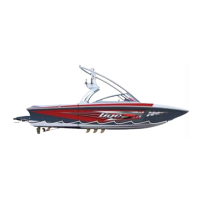
Do you have a question about the Tige Multi-sport Inboard Boat and is the answer not in the manual?
Emphasizes safety priority, owner's role, and general responsibilities for operation.
Covers certifications, hull technology, engine, electronics, and serial number locations.
Addresses operator qualifications, education opportunities, and legal requirements.
Discusses environmental care, warning labels, and specific safety advisories.
Provides boat specifications, boating terminology, and warranty details.
Emphasizes understanding boat operation, hazards, and essential pre-outing checks.
Details essential safety gear, PFDs, navigation lights, and fire extinguishers.
Covers visual distress signals and other recommended safety items for emergencies.
Addresses fire, flooding, collisions, grounding, weather, and specific hazards.
Covers boating under influence, skill, communication, and CO hazards.
Guidelines for water sports, towing, and specific activity warnings.
Pre-trailering checks for safe towing of the boat.
Explains buoys, markers, and their meanings for safe navigation.
Details types of buoys, regulatory markers, and lateral aids.
Covers isolated danger markers and obstructions.
Explains right-of-way rules, horn signals, and passing procedures.
Rules for overtaking, general prudential rules, and night operation.
Illustrates typical V-drive and direct drive layouts of the boat.
Identifies switches, controls, gauges, and indicators on the dash.
Explains operation of various switches like bilge pump, blower, lights, and ignition.
Explains shifter/throttle control, TAPS2, and Tigé SpeedSet systems.
Covers 12-Volt ports, iPod/MP3, gauges, and circuit breakers.
Lists fuse locations and describes cockpit/exterior features like swim platform.
Details cockpit seating adjustments, cooler, storage, and battery systems.
Information and warnings regarding the water sports tow pylon and cleats.
Basic principles for starting, shifting, steering, and essential pre-outing checks.
Safe fueling practices and guidelines for shifting gears.
Proper techniques for steering, stopping, and docking the boat.
Engine starting steps and how to adjust the TAPS2 system.
Recommended settings for water sports and using Tigé SpeedSet.
Requirements for safety gear and principles of proper boat loading.
Techniques for maneuvering, handling salt water, and towing procedures.
Proper anchoring techniques and guidelines for performance boating.
Understanding propeller types, pitch, and selection for optimal performance.
Importance of knowing boat systems and using marine-grade parts.
Overview of engines, V-drives, and direct drive transmissions.
Details on steering, propeller shaft, electrical, and fuel systems.
Information on ballast tanks, bilge pumps, and the shower system.
Illustrates typical electrical, fuel, and water systems for V-drive and direct drive.
Essential maintenance tasks for the boat, including fuel system checks.
Guidelines for cleaning and maintaining the boat's interior and exterior finish.
Maintenance for stainless steel, teak platforms, and propeller.
Covers battery, transmission oil, and steering system maintenance.
Periodic checks for systems and procedures for winter storage.
Steps for preparing the boat for storage and checks before next use.
Identifies engine symptoms and their possible causes for quick diagnosis.
Outlines routine maintenance schedules based on hours of operation.
Sections for recording owner details and transferable warranty information.
Forms for logging fuel usage and filing a float plan for safety.
